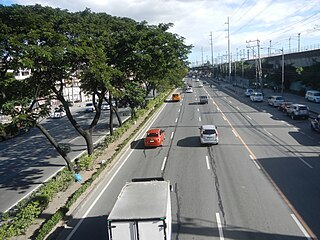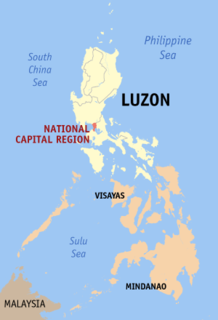
Cainta, officially the Municipality of Cainta,, is a 1st class municipality in the province of Rizal, Philippines. According to the 2015 census, it has a population of 322,128 people.

Monumento LRT station is a station on the Manila LRT (LRT-1). Like all other LRT-1 stations, Monumento is above-ground. The station serves the southern portion of Caloocan, and is named after the most famous landmark of Caloocan, the Monumento Circle, which houses the Bonifacio Monument, a famous monument to Andrés Bonifacio. The name Monumento itself is derived from the Spanish word for monument. Being a former terminal in LRT-1, it is called Monumento Terminal.

V. Mapa station is a station on the Manila Light Rail Transit System Line 2. It is one of the many elevated stations that can be found on the line and also one of the four stations in the line with a reserve track nearby together with Santolan, Anonas and Araneta Center-Cubao. The station during its inception was formerly called as "G. Araneta Station" but was renamed into the current name due to the minor realignment of some stations that has caused the change of proximity to the V. Mapa street. The station serves the areas of Santa Mesa, Manila, Quezon City and San Juan. The station is located at Ramon Magsaysay Boulevard and Victorino Mapa Street at Santa Mesa, Manila.

The Ayala Station is a station on the Manila Metro Rail Transit System Line 3. Ayala station is one of the two underground stations that can be found on the line, the other being the Buendia station. The station is located in Makati and is named so due to its proximity to two places bearing the Ayala name: Ayala Center and Ayala Avenue.

Guadalupe Station is a station on the Manila Metro Rail Transit System Line 3. The station is one of the many elevated stations that can be found on the line. It is located in Makati, Philippines and is named because of its location in Barangay Guadalupe Nuevo in Makati. The barangay is named after Our Lady of Guadalupe.

Balintawak LRT station is a station on the Manila LRT Line 1, and has been constructed during the Line 1 North Extension Project. It opened on March 22, 2010. This station, along with the proposed Malvar station will serve passengers going to and from the northern parts of Luzon using the North Luzon Expressway.

The Marikina–Infanta Highway, also known as the Marcos Highway or MARILAQUE Highway, is a scenic mountain 110-kilometer highway that connects Metro Manila with Infanta, Quezon in the Philippines.
The public transportation system in Metro Manila, Philippines is woefully inadequate to accommodate the mobility and other basic needs of an overpopulated metropolis, the result of many factors and problems that the government has failed to provide or address. Metro Manila exists in a state of near-permanent gridlock, with people and goods trapped by the very transportation system that is supposed to move them quickly and efficiently. Because of the insufficient public transportation network, car ownership has risen dramatically, contributing further to the congestion that occurs at all times of day on the road. Filipinos view cars as tools to get them to where they need to go; they also believe that their car is an important symbol of the success they have achieved in life. In recent years, however, the Philippine government has been pushing to improve the system through various infrastructure projects, hoping to solve the interlinked problems of transportation, land use and environment.

The transportation system in Metro Manila is woefully inadequate to accommodate the mobility and other basic needs of an overpopulated metropolis, the result of many factors and problems that the government has failed to provide or address. Metro Manila exists in a state of near-permanent gridlock, with people and goods trapped by the very transportation system that is supposed to move them quickly and efficiently. Because of the insufficient public transportation network, car ownership has risen dramatically, contributing further to the congestion that occurs at all times of day on the road. Filipinos view cars as tools to get them to where they need to go; they also believe that their car is an important symbol of the success they have achieved in life. In recent years, however, the Philippine government has been pushing to improve the system through various infrastructure projects, hoping to solve the interlinked problems of transportation, land use and environment.
Emerald station is an under construction station on the Manila Light Rail Transit System Line 2 in the Philippines. It is part of the Line 2 East Extension. This station would be the first Line 2 station to be located outside of Metro Manila.

The Manila Metro Rail Transit System (MRT) is one of the two rapid transit systems serving Metro Manila in the Philippines along with the Manila Light Rail Transit System (LRTA). It originally began as a single line that was first opened in 1999 and became fully operational by the year 2000. Since then, most of the newly proposed rapid rail lines within Metro Manila that are not under the jurisdiction of the Light Rail Transit Authority is associated with the "MRT" brand. This includes the Line 9 and the elevated Line 7 which are being built as of March 2019.
Meralco station is a proposed station along the planned Manila Light Rail Transit System Line 4 in Pasig, Metro Manila, Philippines. It will be located near the intersection of Ortigas Avenue and Meralco Avenue in Ugong and will be adjacent to the Manila Electric Company (Meralco) Center building. Under the current proposal, the station will be the second heading east from its interchange with Ortigas MRT station on EDSA towards suburban Taytay along busy Ortigas Avenue.
Julia Vargas station is a proposed station along the planned Manila Light Rail Transit System Line 4 in Quezon City, Metro Manila, Philippines. It will be located at the intersection of Doña Julia Vargas Avenue and ADB Avenue in Ugong Norte adjacent to the Podium.
Pasig station is a proposed station along the planned Manila Light Rail Transit System Line 4 in Pasig, Metro Manila, Philippines. It will be located at the intersection of Ortigas Avenue and Dr. Sixto Antonio Avenue in the Pasig barangay of Rosario, at the foot of the Marikina River crossing of Rosario Bridge from Eulogio Rodriguez Jr. Avenue (C-5).
L. Wood station is a proposed station along the planned Manila Light Rail Transit System Line 4 in Taytay, Rizal, Philippines. It will be located at the Tikling Junction which is the intersection of Ortigas Avenue Extension with Leonard Wood Road and Taytay Diversion Road in the Taytay poblacion of Dolores.
Taytay station is one of two proposed stations along the planned Manila Light Rail Transit System Line 4 in Taytay, Rizal, Philippines. It will be located in Dolores, the poblacion of Taytay, by the SM City Taytay shopping mall on Taytay Diversion Road. It will be the eastern terminus station of Line 4.

The following is an alphabetical list of articles related to the Philippine capital region of Metro Manila.

Metro Manila Subway Line 9, formerly known as the Mega Manila Subway, is an underground rapid transit line currently under construction in Metro Manila, Philippines. The 36-kilometer (22 mi) line, which will run north–south between the cities of Quezon City, Pasig, Makati, Taguig and Pasay, will serve fifteen stations between the Quirino Highway and FTI stations. It will also serve as the country's first direct airport rail link, with a branch line to Ninoy Aquino International Airport. The line is designed to connect with the other urban rail transit services in the region, including Line 1, Line 3, and Line 7 at the North Avenue Common station, which is also currently under construction; the existing Line 2 and Metro Commuter Line; and the planned Line 5 and Line 8.
Lourdes station is a proposed station along the planned Manila Light Rail Transit System Line 4 in Quezon City, Metro Manila, Philippines. It will be located at the intersection of Lourdes Drive and ADB Avenue in Ugong Norte adjacent to the Podium.














